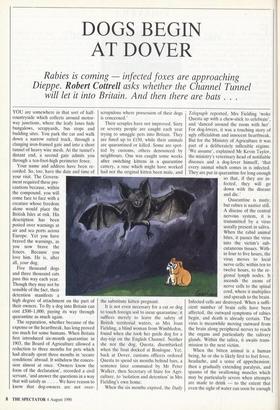DOGS BEGIN AT DOVER
Rabies is coming — infected foxes are approaching Dieppe. Robert Cottrell asks whether the Channel Tunnel will let it into Britain. And then there are bats . . .
YOU are somewhere in that sort of half- countryside which collects around motor- way junctions, where the leafy lanes hide bungalows, scrapyards, bus stops and building sites. You park the car and walk down a narrow rutted track, through a clanging iron-framed gate and into a short tunnel of heavy wire mesh. At the tunnel's distant end, a second gate admits you through a ten-foot-high perimeter fence.
Your name and address have been re- corded. So, too, have the date and time of your visit. The Govern- - ment required these pre- cautions because, within the compound, you will come face to face with a creature whose freedom alone would place the British Isles at risk. His description has been posted over warnings at air and sea ports across Europe. Yet you have
braved the warnings, as you now brave the fences. Because you love him. He is, after all, your dog.
Five thousand dogs and three thousand cats pass this way each year.
Though they may not be sensible of the fact, their detention manifests a high degree of attachment on the part of their owners. To fly a dog into Britain can cost 000-1,000; paying its way through quarantine as much again.
The separation, whether because of the expense or the heartbreak, has long proved too much for some humans. When Britain first introduced six-month quarantine in 1903, the Board of Agriculture allowed a reduction to three months for pets which had already spent three months in 'secure conditions' abroad. It withdrew the conces- sion almost at once. 'Owners know the form of the declaration', recorded a civil servant, 'and answer the questions in a way that will satisfy us . . . . We have reason to know that dog-owners are not over- scrupulous where possession of their dogs is concerned.'
Their scruples have not improved. Sixty or seventy people are caught each year trying to smuggle pets into Britain. They are fined up to 050, while their animals are quarantined or killed. Some are spot- ted by customs, others denounced by neighbours. One was caught some weeks after switching kittens in a quarantine cattery, a ruse which might have worked had not the original kitten been male, and
the substitute kitten pregnant.
It is not even necessary for a cat or dog to touch foreign soil to incur quarantine; it suffices merely to leave the safety of British territorial waters, as Mrs Joan Fielding, a blind woman from Wimbledon, found when she took her guide dog for a day-trip on the English Channel. Neither she nor the dog, Questa, disembarked when the boat docked at Boulogne. Yet, back at Dover, customs officers ordered Questa to spend six months behind bars, a sentence later commuted by Mr Peter Walker, then Secretary of State for Agri- culture, to 'isolation and detention' in Mrs Fielding's own home.
When the six months expired, the Daily
Telegraph reported, Mrs Fielding 'woke Questa up with a chew-stick to celebrate', and 'danced around the room with her'. For dog-lovers, it was a touching story of ugly officialdom and innocent heartbreak. But for the Ministry of Agriculture it was part of a deliberately inflexible regime. 'We assume', explained Mr Kevin Taylor, the ministry's veterinary head of notifiable diseases and a dog-lover himself, 'that every animal which comes in is infected. They are put in quarantine for long enough so that, if they are in- fected, they will go down with the disease and die.'
When the bitten animal is a human being, he or she is likely first to feel fever, headache, and a sense of apprehension; then a gradually extending paralysis, and spasms of the swallowing muscles which may be particularly severe when attempts are made to drink -- to the extent that even the sight of water can soon be enough to provoke strong reaction. Delirium and convulsions follow, ended within a few days by death from respiratory paralysis. In Europe, though not in the European Community, 30 people have died of rabies in the past ten years; in India, 500 die each week.
Virtually all mammals are susceptible to rabies. Even the deer of Richmond Park fell prey to an outbreak in 1886, and, a warden recorded, 'flew at one another like dogs'. But the most dangerously rabid animals are those which are also disposed to spread it. Dogs and cats are considered the domestic animals most likely to trans- mit the disease to man. At the other extreme, elephants, dolphins and a num- ber of other exotic mammals are consi- dered to pose so little a risk that they are not even subject to quarantine. Neither, more surprisingly, are horses, an exemp- tion which seems to owe more to the economic importance of the British blood- stock industry than to the mathematics of public health.
To survive for long periods in the wild, rabies must establish its 'reservoir' among animals which exist in large enough num- bers, and which can carry the virus for a long enough time, for the rate of new infections to exceed the rate of deaths. In Central and South America, vampire bats form the main 'vector' of disease; in Europe, foxes. The present epizootic (the animal version of an epidemic) in Western Europe dates from the second world war when, unhampered by the public health inspectors, vaccination drives and systema- tic slaughtering which had suppressed them in the inter-war years, rabid foxes crossed from Russia into Poland. They reached West Germany in 1950, Belgium in 1966, and north-eastern France in 1968. Last year, they crossed the Loire. Then, in March this year, a rabid fox was found near Dieppe, just 10 miles from the Normandy coast. It is now quite possible, therefore, that the completion of the Channel l'un- nel's service tunnel later this year, the first fixed link between England and France, will coincide more or less exactly with the arrival of the French rabies 'front' at the Channel itself.
On the one hand, a rather awful con- junction of events. On the other, a rather fortuitous one, if you take the view that the
British Government clearly finds rabies rather useful both as a rationale for con-
tinuing border controls beyond 1992, and as a proxy — almost a metaphor — for the many other consequences of European integration which it would like to resist.
I suggested to Mr Taylor that, judging by noises from both Brussels and London, the arrival of the European Community's Sing- le European Market was probably not going to make much of a dent in Britain's quarantine controls. He agreed. 'Nineteen ninety-two is supposed to be about free movement. Free movement does not envis- age quarantine. The continentals argue that vaccination would prevent the intro- duction of the disease. We do not believe it . . . . There is no doubt in my mind that quarantine will continue beyond 1992.'
Other European Community govern- ments do, in fact, understand British — and Irish — concern about rabies. (Ireland operates a similar quarantine system to Britain, and is also free of rabies). If they did not have such extensive land borders, they would probably be quarantining anim- als themselves. Instead, they are attemp- ting to eradicate the disease from infected regions through mass vaccination program- mes. Chickens' heads and fishmeal paste are baited with a weakened form of rabies virus, or, more recently, a genetically engineered variant, and scattered in the paths of foxes. Switzerland has already come close to eradicating rabies from its own soil using this technique. West Ger- many, which records 4-6,000 cases of animal rabies each year, has cleared tens of thousands of square miles.
Britain applauded the aims of the Euro- pean rabies programmes, said Mr Taylor, but wanted to see their long-term results. 'The line that we take is, "First of all, we are very pleased that you have this techni- que . . . Second, please go ahead and vac- cinate and eradicate the disease. And by eradicating we mean that you vaccinate for a number of years until you no longer get outbreaks of disease . . . . Then you stop vaccinating, and you still don't get any outbreaks of disease. When you can say that, then you have truly eradicated it. Then come and talk to us." ' And even when rabies had become but a distant memory in the 12 EEC countries, Britain would still want to see a rabies-free cordon sanitaire established by vaccination deep into ale countries of Scandinavia and central and eastern Europe, to guard
against reinfection, before it even consi- dered dropping its own guard.
As the Ministry of Agriculture is pleased to observe, Britain's decision to begin quarantine in 1903, after a 15–year period during which rabies had killed 173 people in England and Wales, has proved com- pletely successful. After a rash of cases in 1918-22, probably due to dogs smuggled in by returning soldiers, and apart from a scare in 1970 caused by infection within a quarantine kennel, Britain has been rabies- free for almost seven decades. Whether it remains so for another seven will probably depend upon two new factors: bats, and the Channel Tunnel.
When a House of Lords select commit- tee considered the Channel Tunnel bill, it 'listened with sympathy to the fears ex- pressed by Petitioners' who insisted that rabid foxes would soon be emerging from the earthworks at Cheriton. But it listened with rather more sympathy to Mr Anthony Crowley, Eurotunnel's consultant veter- inarian (and, before that, veterinary head of the Ministry of Agriculture's rabies department) who described an arsenal of proposed anti-rabies weapons, including fences, television monitors, dog patrols, and electrified grids. The Lords pro- nounced themselves satisfied that the pos- sibility of tunnel-borne rabies was 're- mote'.
Paramilitary hardware apart, however, there will be another and less glamorous aspect to tunnel security upon which its freedom from rabies is just as likely to turn: the job simply of keeping the place clean. If food and rubbish is allowed to accumulate there, rodents will find a way to it no matter how many gnaw-proof fences are placed in their way. Eurotunnel promises that 'strict measures will be adopted to prevent a build-up of rubbish and for the collection of discarded food', which is all very well, except that there are probably also 'strict measures' written down somewhere for keeping Oxford Street and the London Underground free from 'rubbish and discarded food'. If we expect the French to accommodate British anti-rabies weaponry, we might be modest enough in turn to rely upon France for some expertise in sanitation.
Bats are more of a waiting game. The clustering, nipping, grooming and squab- bling which make up the everyday life of a bat colony provides the ideal means for a single rabid bat to pass the disease on to large numbers of its colleagues. Though much less of a problem than the American vampire bat, European bats — particularly the serotine variety — have long been identified as rabies carriers in the Soviet Union and parts of Scandinavia, places from which they posed little threat to Britain. At the end of last year, however, two rabid serotine bats were caught in Meurthe-et-Moselle, eastern France: the same part of the country at which terrest- rial rabies arrived in 1968. One problem with bats is that they are a protected species whose slaughter would be unpopular; the other is that their behaviour, and particularly their move- ment, is much less well documented than that of foxes. Serotine bats from France would be capable of flying across the Channel, it they wanted to; or, for that matter, colonising the Channel Tunnel if they could slip past the Eurotunnel bat- catchers first. Arriving in Britain, they would find happy bands of other serotine bats in the south of England with which to consort.
For the time being, Britain can only watch and wait. Government scientists have examined hundreds of British bats over the past four years, and found no evidence of rabies among them. They also believe that the bat-borne rabies virus has one characteristic of comfort to society if not to its immediate victim; though it may spread easily among bats, it does not do so among other animals. An animal bitten by a rabid bat will die, but will not infect others of its own species.
The Government was prepared to slaughter dogs in 1902 to end one outbreak of rabies, and is prepared to slaughter foxes now if necessary to end another. But if a rabid serotine bat were caught in Surrey, would it slaughter protected bats?
If rabid rats were found near Folkestone, would it close the Tunnel until surfaces had been disinfected and new defences instal- led? It would probably be capable of anything. For a disease which has not claimed a single life within the European Community for twelve years now, rabies — assisted by official propaganda — arouses strangely atavistic responses.
The British do not even love animals; they merely feel strongly about them, across a wide spectrum of emotions. Dogs in particular now enjoy so poor a press that freedom from rabies is just about their only remaining claim to virtue. Think, then, as you leave your caged dog or cat howling to the moon for liberty and friendship, of quarantine as a social rather than as a medical investment. Of course you know that he has not got rabies, and of course you should not need to spend six months proving this elementary fact to some face- less animal-hating bureaucracy which is probably in league with the kennels and catteries to extort outrageous boarding fees from distraught foreigners and ex- patriates who are soft-hearted enough to love their pets and soft-headed enough to import them. But — at least until the rabid serotine bats swarm over Kent — he will, when he leaves, be above suspicion. If he salivates and bites a neighbour, his head will not be cut off and sent to a government laboratory. If he strays, you may get him back alive. On balance, that is probably a better situation all round.
Robert Cottrell is on the staff of the Inde- pendent.


















































 Previous page
Previous page